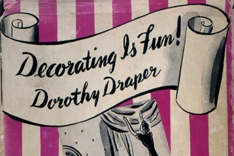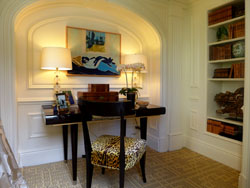Feng Shui Tips - The Power of Color in Decorating
 Guest Blog
Guest Blog  Monday, June 11, 2012 at 9:00AM
Monday, June 11, 2012 at 9:00AM Franca Giuliani - Within feng shui as within design, color is very important and powerful. Before trying to pick out the "right color” for home decorating, let's try to understand color.
Color is energy. (And, remember,everything is energy.) Colors are specific wavelengths of energy that can be used to balance ourchi, our life force. Here's what colors can do for you and yours:
- Colors have an impact on our emotions and our vibration. They possess the power to arouse or to tranquilize, to bring joy or create depression.
- Colors engage our eyes and influence how we interpret our emotional experiences. By understanding the emotional context of colors, we can manipulate the experience of space to benefit our energetic body.
Color Has Three Dimensions
HUE: This is the first recognizable characteristic of a color. It's the quality by which we distinguish one color from another, as red, yellow, etc.
VALUE: The quality by which we distinguish a light color from a dark color (or how clean the color is). Value is raised by adding white and is lowered by adding black. Colors change in value with light - the brighter the sun, the more light you have coming into a room, the brighter the room colors will be.
INTENSITY: The quality by which we distinguish a strong color from a weak one. Color is lowered in intensity by adding gray or by adding its complementary color.
Color Has Harmony
 This is an agreeable combination of colors, and there are two kinds of harmony.
This is an agreeable combination of colors, and there are two kinds of harmony.
CONTRASTED HARMONIES use colors on the opposite side of the color wheel. Most common are complementary colors - exactly opposite.
RELATED HARMONY uses colors close to each other on the color wheel or only one color. Analogous colors are adjacent on the wheel and monochromatic colors are using one color with varying values of one color.
White and black are technically not colors. White is a tint and black is a shade. White is actually all colors reflecting off a surface. Black is all colors absorbed into the surface (the absence of color).
10 General Color Tips
Color can be used to compensate for deficiences in your living environment and as a way of enhancing or augmenting your potentials.
- Avoid dull, flat colors such as grey or beige. They stifle creativity and efficiency. If you can’t avoid using them, bring in more life with flowers, or bright art or pictures, but avoid "color pollution."
- It's better to have light, bright colors than either very strong or very weak colors.
- Red is very auspicious and passionate. Add a small amount of bright red to an environment to enhance the power base of the individual occupying the space. But less is more - too much of it may cause arguments.
- Green in general means potential, growth, tranquility, hope, and freshness. Soft greens and blues will calm nerves and lower voices.
- Routine tasks that require extended periods of concentration are supported by green.
- Yellow is effective in energizing creativity and brainstorming. It represents longevity.
- Soft blue or purple is helpful for work that requires deep thinking or imagination.
- Use warm soft yellow, orange, or peach to compensate for slow, uninspiring work.
- Use pink or peach to enhance love and soften relationships.
- Too much black can be draining and cause depression.
Your Feng Shui Homework
Your homework for this month is to go through each of the rooms in your space, and look at your room colors with a fresh eye.
Observe the main colors. How do they make you feel?
Take your time with this assignment, so you can really understand how the colors are affecting you. Then, you can decide if anything needs to change.

Franca is one of the Feng Shui instructors at Sheffield School; visit her website for more information. If you're interested in learning more about interior design and accessories, then we encourage you to explore the Sheffield School, New York, NY. Sheffield began as an Interior Design school in 1985, and then expanded our course offerings to train people in other design-related fields, including Feng Shui, Wedding and Event Planning, and Jewelry Design. With thousands of active students and more than 50,000 graduates, Sheffield has trained more design professionals than any school in the world.
- Request a free Sheffield School catalog describing our distance education courses.
- Subscribe to the Sheffield Designer newsletter.







Reader Comments (6)
Thank you very much!